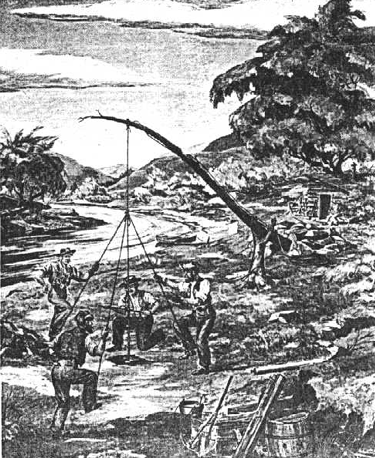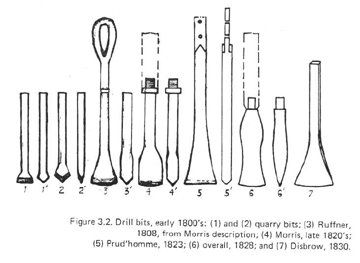The Ruffner brothers' well was drilled on the right bank of the Great Kanawha River within the city limits of what is now Charleston, West Virginia. This well was dug and drilled for brine for the extraction of salt to supply the rapidly increasing number of settlers in this frontier region, which was then within the state of Virginia.
This is considered to have been one of the three most important wells drilled in America. The other two were the Drake well drilled 1858-59 near Titusville, Pennsylvania, and the great Lucas well drilled 1900-01 near Beaumont, Texas.
The Ruffner brothers' well was the first well known to have been "drilled," as distinct from "dug," in the Western Hemisphere. Its fame and importance rests on the above fact and on the "invention" and development of well drilling tools and practices, which became almost immediately standard equipment used by many other well drillers in the new salt industry.
Basically, similar tools and practices have continued in use until this day. An equally or still more important result was that wells drilled for salt by others, immediately following the Ruffner well, discovered oil and gas in what today would be commercial quantities. The gas found in many of these wells, as previously stated, was used as fuel to evaporate brine for the recovery of salt and for lighting. The oil was used sparingly as seepage oil had been used for many years.
In order to reach, if possible, the bottom of the mire and oozy quicksand through which the water flowed, they provided a straight well-formed, hollow sycamore tree, with four feet internal diameter, sawed off square at each end. This is technically called a 'gum', This gum was set upright on the spot selected for sinking, the large end down, and held in its perpendicular position by props or braces, on the four sides.
A platform upon which two men could stand, was fixed about the top; then a swape erected, having its fulcrum in a forked post set in the ground close by. A large bucket, made from half of a whisky barrel, was attached to the end of the swape, by a rope, and a rope attached to the end of the pole to pull down on, to raise the bucket. With one man inside the gum armed with pick, shovel and crowbar, and three or four to work the swape, the crew and outfit were complete.
In preparing to drill a well, the Ruffners were undertaking a job with which they had had no experience nor had anyone else in the country for that matter. They appear to have had some knowledge of or at least to have observed quarry operations, however. After landing the "gum" on firm rock and shutting off the surface water, they concluded that they would have to bore or drill a hole into the rock to obtain the stronger brine issuing from it in very small quantities. Insofar as they knew, this had never been done.
They knew, however, that in quarry operations shot holes several feet deep were drilled in the rock with steel chisel drills by striking the short drill shanks with a hammer in shallow holes and by dropping the steel chisels with extended shanks in the deeper holes. They already had 17 ft. of "bee gum" cased hole and thus welded an iron rod to the short steel chisel bit shank. They then bent a loop in the upper end of the stem, to which the drilling line could be attached. The overall length of the bit and shank was about 10 ft. and weighed 30 to 40 pounds. A manila rope, probably 1 in. in diameter, attached to the loop of the drill stem for picking up and dropping the drilling bit.
The top of the gum was doubtlessly about level with the surface of the ground, with the bottom resting on bedrock 17 ft. down, as stated. The hole was dry, or practically so.
A small tree, probably hemlock, was cut in the nearby wooded hills and trimmed 20 to 25 ft. in length. The butt end was fixed at ground level at a point that placed the end of the pole slightly beyond the center of the bee gum surface conductor. A forked heavy limb was then placed under the pole and set in the ground about one third the distance from the butt end to the small end, and it was of sufficient height to have raised the end of the pole 6 or 7 ft. above the level of the top of the bee gum. The rope was then passed two or three times around the upper end of the pole at the point directly over the center of the hole.
A short rope with a loop in the lower end was then fastened to the pole near the wraps of the drilling rope or line. Several poles were laid across the top of the bee gum conductor pipe for a working platform under the pole. The spring pole, which was to be used as almost the only drilling motion machine for years to come was ready to drill what was probably its first hole--at least, in America. No record or suggestion of any other such tool has been found except in the early Chinese drilling rigs, which used a spring board of quite different design and operation but with the same motion.
The drilling motion of the Ruffner springpole was developed by foot power. The foregoing outline has been reconstructed from the meager records of well drilling equipment of the early 1800's and from the few patent descriptions. Figure 3.1 is an artist's sketch of a springpole drilling operation on the Kanawha River.

The Ruffner tools from the springpole down probably consisted of a manila line attached to a loop in the extended shank of the 2'/2 in. quarry drill. Such bits or drills are illustrated in Figure 3.2.

The method used by the Ruffners for cleaning or bailing the hole is not known. The writer would assume that they used a straight 1 in. (more or less) hickory pole with a battered end as a swab until the hole was too deep for this tool and then rigged up a bailer of thin sheet iron or copper with a ball or flapper valve in the bottom. Such tools appear to have been in common use a few years later.
Having now sufficient salt water to justify it, they decided and commenced, to build a salt furnace; but while building, continued the boring, and on the 15th of January, 1808, at 40 feet in the rock, and 58 feet from the top of the gum, were rewarded by an ample flow of strong brine for their furnace, and ceased boring.